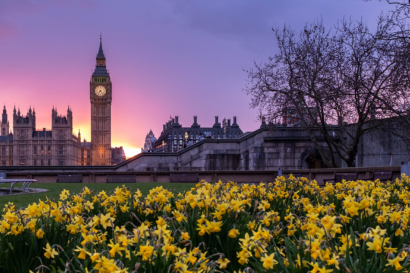AG INSIGHT | 09/02/2023
The UK has a new five-year nature policy plan. What’s next?

Delivery must be the priority to drive improvements in the natural environment.
2023 has already been a busy year for nature. The past few weeks have seen the publication of the Office for Environmental Protection’s second monitoring report, the release of further details on the different environmental land management schemes, the introduction of the plant biosecurity strategy, and the formal passage of the long-term targets for environmental improvement via secondary legislation. Now we have also seen the first refreshed environmental improvement plan (EIP) published by the Department for Environment, Food and Rural Affairs (Defra).
This represents a significant step forward towards a more holistic approach to getting the UK’s environment back on track. For the first time, we have a cohesive strategy that includes a wide range of the natural environment and outlines how Government will support delivery on the ground. The Plan builds on the vision set out in the 25 Year Environment Plan, but addresses some of its shortcomings – it provides greater detail and sets out interim targets to meet the UK’s environmental goals. The document further incorporates commitments made as part of the Montreal-Kunming agreement at CBD COP15 international biodiversity summit, linking domestic and international commitments.
Together with the publication of the environmental principles policy statement, the building blocks of the UK’s new environmental governance regime has been set. This invites the question – what next for nature in the UK?
The answer can be summarised in one word: delivery. Delivering policy and environmental schemes will be key to drive business and public investment in nature and maximise economic benefits and job creation in environmental sectors. Achieving this will be complex – it will require a relentless cross-government focus; new partnership working; coordination between national, local and devolved governments; the mobilisation of both public and private investment; and additional clarity on policy developments in key areas in order to deliver improvements on the ground.
Mobilisation of public and private investment
While the targets and governance framework for nature is predominantly focused on public bodies, it is undeniable that a lot of the delivery on the ground will need to come from the private sector. To realise this potential, it is important that the EIP provides a stable framework in which businesses can operate and unlock private investment.
Ambitious, well-designed and properly enforced environmental regulations must be a priority to provide a stable environment for businesses to invest in, support innovation in new green solutions and products, and provide a level playing field across the economy. This delivers both environmental improvements and economic growth, including the development of high-quality products and services and an increase in business competitiveness – resulting in job creation and enhanced research, development and skills.
A notable case study demonstrating this is the Landfill Tax, which created a whole industry while also reducing landfill waste by 72% between the 2016/17 and 1996/97 financial year. It incentivised the industry to invest in new infrastructure and services, which in turn delivered a net positive job impact where jobs tend to require higher skills and engineering needs.
This also underscores the vital role of regulators. It is critical that regulators and watchdogs are sufficiently resourced and equipped to respond to the increased need to deliver improvements, whilst still safeguarding the environment.
The new Office for Environmental Protection has already highlighted the need for further funding for it to carry out its essential work, and to “grow in all our core functions to deliver as Parliament and the Assembly intended, and to provide resilience to ensure we can operate safely”.
Nature must be embedded throughout Government
It will also be crucial that all government departments incorporate not just environmental targets into their work but also embed nature throughout – in the same way that the UK’s net zero emissions target has been embraced across Government. The EIP acknowledges work throughout Government to restore nature, but the majority of this effort is carried by Defra. There is a clear opportunity for departments like the Department for Business, Energy and Industrial Strategy to more radically embrace increased resource efficiency to not only reduce our environmental footprint, but also to incentivise a more circular economy.
For example, research has shown that improving resource efficiency in construction, vehicles, food and drink, electronics and appliances, and textiles could enable the UK to meet its Fourth Carbon Budget and reduce the expected emissions gap to meet the Fifth Carbon Budget by nearly 80%. A more circular economy could also create over 200,000 gross jobs and reduce unemployment by about 54,000 jobs by 2030. These figures clearly illustrate the potential that can be unlocked by acting on resource efficiency – a key plank of the EIP – from a business perspective.
This whole-of-government aspect also was reflected in the speech made by the Secretary of State for Environment, Food and Rural Affairs, Rt Hon Thérèse Coffey MP, when launching the EIP. The speech also noted the crucial role of the environmental principles policy statement – which will embed environmental protection and enhancement into the design and development of new policy across Government from 1 November 2023. Ensuring this is a success will be crucial to restoring nature.
Addressing the policy gaps
When the environmental targets were announced by Government, they went beyond the legal minimum by setting several targets per priority area. This was particularly welcomed by businesses, including many from the Aldersgate Group’s membership. However, there are some existing gaps in the overall environmental framework that will need to be addressed swiftly These include the need to introduce an ambitious resource productivity target to drive greater resource efficiency across material intensive sectors of the economy beyond just packaging, and the importance of introducing outcomes focused targets and policies to quickly deliver improvements in water quality. There is also no target for protected sites in the EIP. Whilst delivery of other biodiversity targets will necessitate action for Sites of Special Scientific Interest (SSSIs), this will nevertheless be an important area for further development.
These are some of the examples where additional work will be required to accelerate improvements, and further policy signals in these areas will help ensure confidence in delivery.
We need a decade of delivery
The science is very clear: we need to see environmental improvements fast, and this cannot merely be preventing environmental harm. We also need to see every opportunity to deliver environmental enhancement maximised if we are to reverse the decline of the natural environment within a generation, and especially if we are to halt the decline in species abundance by 2030.
This must become a decade of delivery – with all parts of society, business and government working together to achieve change on the ground and restore the environment.



